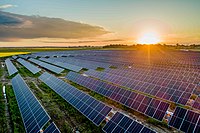
Photo from wikipedia
As the scaling of silicon PV cells and module manufacturing has driven solar energy penetration up and costs down, concentrator photovoltaic technologies, originally conceived as a cost-saving measure, have largely… Click to show full abstract
As the scaling of silicon PV cells and module manufacturing has driven solar energy penetration up and costs down, concentrator photovoltaic technologies, originally conceived as a cost-saving measure, have largely been left behind. The loss of market share by CPV is being locked in even as solar energy development encounters significant obstacles related to space constraints in many parts of the world. The inherently higher collection efficiency enabled by the use of concentrators could substantially alleviate these challenges, but the revival of CPV for this purpose requires substantial reinvention of the technology to actually capture the theoretically possible efficiency gains, and to do so at market-friendly costs. This article will discuss recent progress in key areas central to this reinvention, including miniaturization of cells and optics to produce compact, lightweight “micro-CPV” systems; hybridization of CPV with thermal, illumination and other applications to make use of unused energy streams such as diffuse light and waste heat; and the integration of sun-tracking into the CPV module architecture to enable greater light collection and more flexible deployment, including integration into built structures. Applications showing particular promise include thermal applications such as water heating, industrial processes and desalination; agricultural photovoltaics; building-integrated photovoltaics with dynamic daylighting capabilities; and chemical processes including photocatalysis and hydrogen production. By appropriately tailoring systems to the available solar resource and local energy demand, we demonstrate how CPV can finally achieve real-world efficiencies, or solar resource utilization factors, far higher than those of standard silicon-based PV systems. This makes the argument for sustained development of novel CPV designs that can be applied to the real-world settings where this efficiency boost will be most beneficial.
Journal Title: Energies
Year Published: 2021
Link to full text (if available)
Share on Social Media: Sign Up to like & get
recommendations!